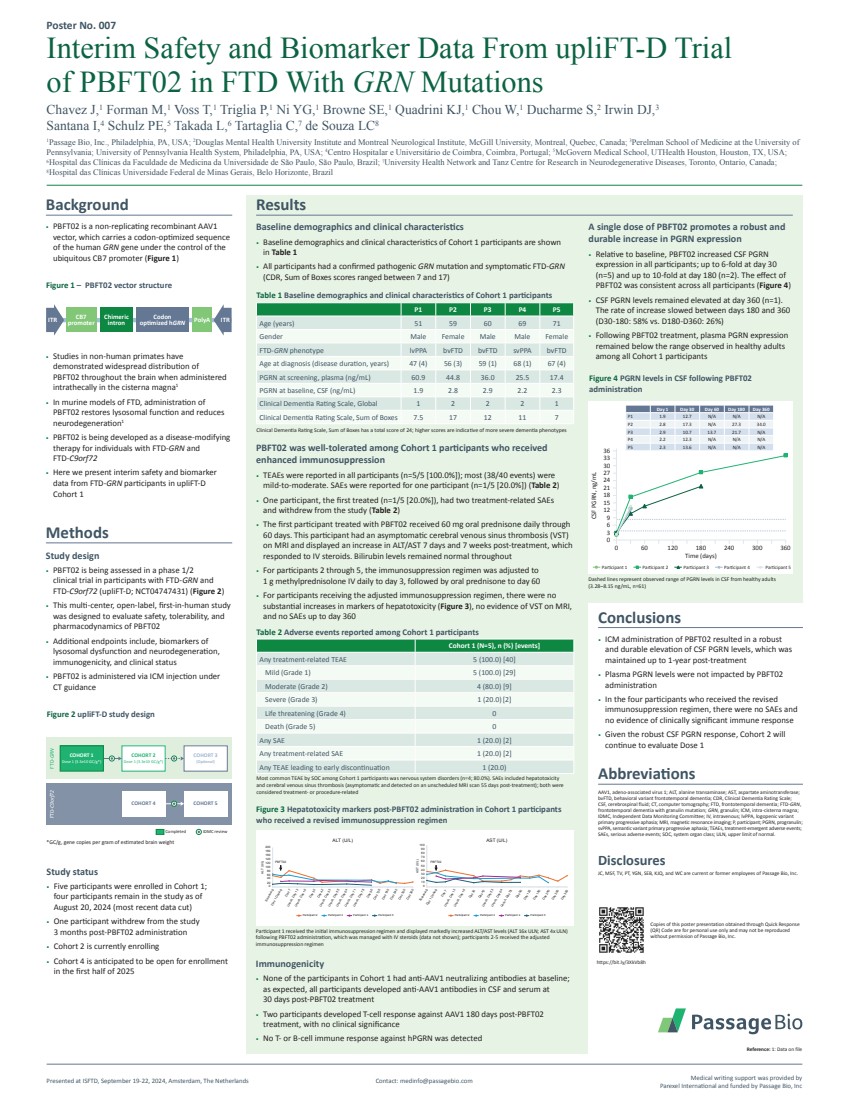
| W�&dϬϮǁĂƐǁĞůůͲƚŽůĞƌĂƚĞĚĂŵŽŶŐ�ŽŚŽƌƚϭƉĂƌƟĐŝƉĂŶƚƐǁŚŽƌĞĐĞŝǀĞĚ
ĞŶŚĂŶĐĞĚŝŵŵƵŶŽƐƵƉƉƌĞƐƐŝŽŶ
• d���ƐǁĞƌĞƌĞƉŽƌƚĞĚŝŶĂůůƉĂƌƟĐŝƉĂŶƚƐ;ŶсϱͬϱϭϬϬ͘ϬйͿ͖ŵŽƐƚ;ϯϴͬϰϬĞǀĞŶƚƐͿǁĞƌĞ
ŵŝůĚͲƚŽͲŵŽĚĞƌĂƚĞ͘��ƐǁĞƌĞƌĞƉŽƌƚĞĚĨŽƌŽŶĞƉĂƌƟĐŝƉĂŶƚ;ŶсϭͬϱϮϬ͘ϬйͿ;Table 2Ϳ
• KŶĞƉĂƌƟĐŝƉĂŶƚ͕ƚŚĞĮƌƐƚƚƌĞĂƚĞĚ;ŶсϭͬϱϮϬ͘ϬйͿ͕ŚĂĚƚǁŽƚƌĞĂƚŵĞŶƚͲƌĞůĂƚĞĚ��Ɛ
ĂŶĚǁŝƚŚĚƌĞǁĨƌŽŵƚŚĞƐƚƵĚLJ;Table 2Ϳ
• dŚĞĮƌƐƚƉĂƌƟĐŝƉĂŶƚƚƌĞĂƚĞĚǁŝƚŚW�&dϬϮƌĞĐĞŝǀĞĚϲϬŵŐŽƌĂůƉƌĞĚŶŝƐŽŶĞĚĂŝůLJƚŚƌŽƵŐŚ
ϲϬĚĂLJƐ͘dŚŝƐƉĂƌƟĐŝƉĂŶƚŚĂĚĂŶĂƐLJŵƉƚŽŵĂƟĐĐĞƌĞďƌĂůǀĞŶŽƵƐƐŝŶƵƐƚŚƌŽŵďŽƐŝƐ;sdͿ
ŽŶDZ/ĂŶĚĚŝƐƉůĂLJĞĚĂŶŝŶĐƌĞĂƐĞŝŶ�>dͬ�dϳĚĂLJƐĂŶĚϳǁĞĞŬƐƉŽƐƚͲƚƌĞĂƚŵĞŶƚ͕ǁŚŝĐŚ
ƌĞƐƉŽŶĚĞĚƚŽ/sƐƚĞƌŽŝĚƐ͘�ŝůŝƌƵďŝŶůĞǀĞůƐƌĞŵĂŝŶĞĚŶŽƌŵĂůƚŚƌŽƵŐŚŽƵƚ
• &ŽƌƉĂƌƟĐŝƉĂŶƚƐϮƚŚƌŽƵŐŚϱ͕ƚŚĞŝŵŵƵŶŽƐƵƉƉƌĞƐƐŝŽŶƌĞŐŝŵĞŶǁĂƐĂĚũƵƐƚĞĚƚŽ
ϭŐŵĞƚŚLJůƉƌĞĚŶŝƐŽůŽŶĞ/sĚĂŝůLJƚŽĚĂLJϯ͕ĨŽůůŽǁĞĚďLJŽƌĂůƉƌĞĚŶŝƐŽŶĞƚŽĚĂLJϲϬ
• &ŽƌƉĂƌƟĐŝƉĂŶƚƐƌĞĐĞŝǀŝŶŐƚŚĞĂĚũƵƐƚĞĚŝŵŵƵŶŽƐƵƉƉƌĞƐƐŝŽŶƌĞŐŝŵĞŶ͕ƚŚĞƌĞǁĞƌĞŶŽ
ƐƵďƐƚĂŶƟĂůŝŶĐƌĞĂƐĞƐŝŶŵĂƌŬĞƌƐŽĨŚĞƉĂƚŽƚŽdžŝĐŝƚLJ;&ŝŐƵƌĞϯͿ͕ŶŽĞǀŝĚĞŶĐĞŽĨsdŽŶDZ/͕
ĂŶĚŶŽ��ƐƵƉƚŽĚĂLJϯϲϬ
Interim Safety and Biomarker Data From upliFT-D Trial
of PBFT02 in FTD With GRN Mutations
Chavez J,1
Forman M,1
Voss T,1
Triglia P,1
Ni YG,1
Browne SE,1
Quadrini KJ,1
Chou W,1
Ducharme S,2
Irwin DJ,3
Santana I,4
Schulz PE,5
Takada L,6
Tartaglia C,7
de Souza LC8
1
Passage Bio, Inc., Philadelphia, PA, USA; 2
Douglas Mental Health University Institute and Montreal Neurological Institute, McGill University, Montreal, Quebec, Canada; 3
Perelman School of Medicine at the University of
Pennsylvania; University of Pennsylvania Health System, Philadelphia, PA, USA; 4
Centro Hospitalar e Universitário de Coimbra, Coimbra, Portugal; 5
McGovern Medical School, UTHealth Houston, Houston, TX, USA; 6
Hospital das Clínicas da Faculdade de Medicina da Universidade de São Paulo, São Paulo, Brazil; 7
University Health Network and Tanz Centre for Research in Neurodegenerative Diseases, Toronto, Ontario, Canada; 8
Hospital das Clínicas Universidade Federal de Minas Gerais, Belo Horizonte, Brazil
�ďďƌĞǀŝĂƟŽŶƐ
��sϭ͕ĂĚĞŶŽͲĂƐƐŽĐŝĂƚĞĚǀŝƌƵƐϭ͖�>d͕ĂůĂŶŝŶĞƚƌĂŶƐĂŵŝŶĂƐĞ͖�d͕ĂƐƉĂƌƚĂƚĞĂŵŝŶŽƚƌĂŶƐĨĞƌĂƐĞ͖
ďǀ&d�͕ďĞŚĂǀŝŽƌĂůǀĂƌŝĂŶƚĨƌŽŶƚŽƚĞŵƉŽƌĂůĚĞŵĞŶƚŝĂ͖��Z͕�ůŝŶŝĐĂů�ĞŵĞŶƚŝĂZĂƚŝŶŐĐĂůĞ͖
�&͕ĐĞƌĞďƌŽƐƉŝŶĂůĨůƵŝĚ͖�d͕ĐŽŵƉƵƚĞƌƚŽŵŽŐƌĂƉŚLJ͖&d�͕ĨƌŽŶƚŽƚĞŵƉŽƌĂůĚĞŵĞŶƚŝĂ͖&d�ͲGRN͕
ĨƌŽŶƚŽƚĞŵƉŽƌĂůĚĞŵĞŶƚŝĂǁŝƚŚŐƌĂŶƵůŝŶŵƵƚĂƚŝŽŶ͖GRN͕ŐƌĂŶƵůŝŶ͖/�D͕ŝŶƚƌĂͲĐŝƐƚĞƌŶĂŵĂŐŶĂ͖
/�D�͕/ŶĚĞƉĞŶĚĞŶƚ�ĂƚĂDŽŶŝƚŽƌŝŶŐ�ŽŵŵŝƚƚĞĞ͖/s͕ŝŶƚƌĂǀĞŶŽƵƐ͖ůǀWW�͕ůŽŐŽƉĞŶŝĐǀĂƌŝĂŶƚ
ƉƌŝŵĂƌLJƉƌŽŐƌĞƐƐŝǀĞĂƉŚĂƐŝĂ͖DZ/͕ŵĂŐŶĞƚŝĐƌĞƐŽŶĂŶĐĞŝŵĂŐŝŶŐ͖W͕ƉĂƌƚŝĐŝƉĂŶƚ͖W'ZE͕ƉƌŽŐƌĂŶƵůŝŶ͖
ƐǀWW�͕ƐĞŵĂŶƚŝĐǀĂƌŝĂŶƚƉƌŝŵĂƌLJƉƌŽŐƌĞƐƐŝǀĞĂƉŚĂƐŝĂ͖d���Ɛ͕ƚƌĞĂƚŵĞŶƚͲĞŵĞƌŐĞŶƚĂĚǀĞƌƐĞĞǀĞŶƚƐ͖
��Ɛ͕ƐĞƌŝŽƵƐĂĚǀĞƌƐĞĞǀĞŶƚƐ͖K�͕ƐLJƐƚĞŵŽƌŐĂŶĐůĂƐƐ͖h>E͕ƵƉƉĞƌůŝŵŝƚŽĨŶŽƌŵĂů͘
�ŝƐĐůŽƐƵƌĞƐ
:�͕D&͕ds͕Wd͕z'E͕��͕<:Y͕ĂŶĚt�ĂƌĞĐƵƌƌĞŶƚŽƌĨŽƌŵĞƌĞŵƉůŽLJĞĞƐŽĨWĂƐƐĂŐĞ�ŝŽ͕/ŶĐ͘
WƌĞƐĞŶƚĞĚĂƚ/&d�͕ĞƉƚĞŵďĞƌϭϵͲϮϮ͕ϮϬϮϰ͕�ŵƐƚĞƌĚĂŵ͕dŚĞEĞƚŚĞƌůĂŶĚƐ �ŽŶƚĂĐƚ͗ŵĞĚŝŶĨŽΛƉĂƐƐĂŐĞďŝŽ͘ĐŽŵ
�ĂĐŬŐƌŽƵŶĚ
• W�&dϬϮŝƐĂŶŽŶͲƌĞƉůŝĐĂƟŶŐƌĞĐŽŵďŝŶĂŶƚ��sϭ
ǀĞĐƚŽƌ͕ǁŚŝĐŚĐĂƌƌŝĞƐĂĐŽĚŽŶͲŽƉƟŵŝnjĞĚƐĞƋƵĞŶĐĞ
ŽĨƚŚĞŚƵŵĂŶGRNŐĞŶĞƵŶĚĞƌƚŚĞĐŽŶƚƌŽůŽĨƚŚĞ
ƵďŝƋƵŝƚŽƵƐ��ϳƉƌŽŵŽƚĞƌ;&ŝŐƵƌĞϭͿ
�ŽŶĐůƵƐŝŽŶƐ
• /�DĂĚŵŝŶŝƐƚƌĂƟŽŶŽĨW�&dϬϮƌĞƐƵůƚĞĚŝŶĂƌŽďƵƐƚ
ĂŶĚĚƵƌĂďůĞĞůĞǀĂƟŽŶŽĨ�&W'ZEůĞǀĞůƐ͕ǁŚŝĐŚǁĂƐ
ŵĂŝŶƚĂŝŶĞĚƵƉƚŽϭͲLJĞĂƌƉŽƐƚͲƚƌĞĂƚŵĞŶƚ
• WůĂƐŵĂW'ZEůĞǀĞůƐǁĞƌĞŶŽƚŝŵƉĂĐƚĞĚďLJW�&dϬϮ
ĂĚŵŝŶŝƐƚƌĂƟŽŶ
• /ŶƚŚĞĨŽƵƌƉĂƌƟĐŝƉĂŶƚƐǁŚŽƌĞĐĞŝǀĞĚƚŚĞƌĞǀŝƐĞĚ
ŝŵŵƵŶŽƐƵƉƉƌĞƐƐŝŽŶƌĞŐŝŵĞŶ͕ƚŚĞƌĞǁĞƌĞŶŽ��ƐĂŶĚ
ŶŽĞǀŝĚĞŶĐĞŽĨĐůŝŶŝĐĂůůLJƐŝŐŶŝĮĐĂŶƚŝŵŵƵŶĞƌĞƐƉŽŶƐĞ
• 'ŝǀĞŶƚŚĞƌŽďƵƐƚ�&W'ZEƌĞƐƉŽŶƐĞ͕�ŽŚŽƌƚϮǁŝůů
ĐŽŶƟŶƵĞƚŽĞǀĂůƵĂƚĞ�ŽƐĞϭ
ZĞƐƵůƚƐ
WĂƌƟĐŝƉĂŶƚϭƌĞĐĞŝǀĞĚƚŚĞŝŶŝƟĂůŝŵŵƵŶŽƐƵƉƉƌĞƐƐŝŽŶƌĞŐŝŵĞŶĂŶĚĚŝƐƉůĂLJĞĚŵĂƌŬĞĚůLJŝŶĐƌĞĂƐĞĚ�>dͬ�důĞǀĞůƐ;�>dϭϲdžh>E͖�dϰdžh>EͿ
ĨŽůůŽǁŝŶŐW�&dϬϮĂĚŵŝŶŝƐƚƌĂƟŽŶ͕ǁŚŝĐŚǁĂƐŵĂŶĂŐĞĚǁŝƚŚ/sƐƚĞƌŽŝĚƐ;ĚĂƚĂŶŽƚƐŚŽǁŶͿ͖ƉĂƌƟĐŝƉĂŶƚƐϮͲϱƌĞĐĞŝǀĞĚƚŚĞĂĚũƵƐƚĞĚ
ŝŵŵƵŶŽƐƵƉƉƌĞƐƐŝŽŶƌĞŐŝŵĞŶ
Time (days)
0 60 120 180 240 300
36
0
3
6
9
12
15
18
21
24
27
30
33
360
CSF PGRN, ng/mL ParƟcipant 1 ParƟcipant 2 ParƟcipant 3 ParƟcipant 4 ParƟcipant 5
0
20
40
60
80
100
120
140
160
180
200
Screening
Day 1 Dosing
Day 7
Unsch. Day 13
Unsch. Day 16
Day 30
Day 42
Unsch. Day 53
Unsch. Day 55
Unsch. Day 64
Unsch. Day 71
Unsch. Day 78
Day 90
Day 120
Day 180
Day 240
Day 300
Day 360
ALT (U/L)
ALT (U/L)
0
10
20
30
40
50
60
70
80
90
100
Screening
Day 1 Dosing
Day 7
Unsch. Day 13
Unsch. Day 16
Day 30
Day 42
Unsch. Day 53
Unsch. Day 64
Unsch. Day 78
Day 90
Day 120
Day 180
Day 240
Day 300
Day 360
AST (U/L)
AST (U/L)
Participant 2 Participant 3 Participant 4 Participant 5 Participant 2 Participant 3 Participant 4 Participant 5
PBFT02 PBFT02
ITR ITR CB7
promoter
Chimeric
intron
Codon
ŽƉƟŵŝnjĞĚŚGRN PolyA
&ŝŐƵƌĞϭʹW�&dϬϮǀĞĐƚŽƌƐƚƌƵĐƚƵƌĞ
&ŝŐƵƌĞϰW'ZEůĞǀĞůƐŝŶ�&ĨŽůůŽǁŝŶŐW�&dϬϮ
ĂĚŵŝŶŝƐƚƌĂƟŽŶ
DĞĚŝĐĂůǁƌŝƟŶŐƐƵƉƉŽƌƚǁĂƐƉƌŽǀŝĚĞĚďLJ
WĂƌĞdžĞů/ŶƚĞƌŶĂƟŽŶĂůĂŶĚĨƵŶĚĞĚďLJWĂƐƐĂŐĞ�ŝŽ͕/ŶĐ
• ƚƵĚŝĞƐŝŶŶŽŶͲŚƵŵĂŶƉƌŝŵĂƚĞƐŚĂǀĞ
ĚĞŵŽŶƐƚƌĂƚĞĚǁŝĚĞƐƉƌĞĂĚĚŝƐƚƌŝďƵƟŽŶŽĨ
W�&dϬϮƚŚƌŽƵŐŚŽƵƚƚŚĞďƌĂŝŶǁŚĞŶĂĚŵŝŶŝƐƚĞƌĞĚ
ŝŶƚƌĂƚŚĞĐĂůůLJŝŶƚŚĞĐŝƐƚĞƌŶĂŵĂŐŶĂϭ
• /ŶŵƵƌŝŶĞŵŽĚĞůƐŽĨ&d�͕ĂĚŵŝŶŝƐƚƌĂƟŽŶŽĨ
W�&dϬϮƌĞƐƚŽƌĞƐůLJƐŽƐŽŵĂůĨƵŶĐƟŽŶĂŶĚƌĞĚƵĐĞƐ
ŶĞƵƌŽĚĞŐĞŶĞƌĂƟŽŶϭ
• W�&dϬϮŝƐďĞŝŶŐĚĞǀĞůŽƉĞĚĂƐĂĚŝƐĞĂƐĞͲŵŽĚŝĨLJŝŶŐ
ƚŚĞƌĂƉLJĨŽƌŝŶĚŝǀŝĚƵĂůƐǁŝƚŚ&d�ͲGRN and
&d�ͲC9orf72
• ,ĞƌĞǁĞƉƌĞƐĞŶƚŝŶƚĞƌŝŵƐĂĨĞƚLJĂŶĚďŝŽŵĂƌŬĞƌ
ĚĂƚĂĨƌŽŵ&d�ͲGRNƉĂƌƟĐŝƉĂŶƚƐŝŶƵƉůŝ&dͲ�
�ŽŚŽƌƚϭ
Methods
ƚƵĚLJĚĞƐŝŐŶ
• W�&dϬϮŝƐďĞŝŶŐĂƐƐĞƐƐĞĚŝŶĂƉŚĂƐĞϭͬϮ
ĐůŝŶŝĐĂůƚƌŝĂůŝŶƉĂƌƟĐŝƉĂŶƚƐǁŝƚŚ&d�ͲGRN and
&d�ͲC9orf72;ƵƉůŝ&dͲ�͖E�dϬϰϳϰϳϰϯϭͿ;&ŝŐƵƌĞϮͿ
• dŚŝƐŵƵůƟͲĐĞŶƚĞƌ͕ŽƉĞŶͲůĂďĞů͕ĮƌƐƚͲŝŶͲŚƵŵĂŶƐƚƵĚLJ
ǁĂƐĚĞƐŝŐŶĞĚƚŽĞǀĂůƵĂƚĞƐĂĨĞƚLJ͕ƚŽůĞƌĂďŝůŝƚLJ͕ĂŶĚ
ƉŚĂƌŵĂĐŽĚLJŶĂŵŝĐƐŽĨW�&dϬϮ
• �ĚĚŝƟŽŶĂůĞŶĚƉŽŝŶƚƐŝŶĐůƵĚĞ͕ďŝŽŵĂƌŬĞƌƐŽĨ
ůLJƐŽƐŽŵĂůĚLJƐĨƵŶĐƟŽŶĂŶĚŶĞƵƌŽĚĞŐĞŶĞƌĂƟŽŶ͕
ŝŵŵƵŶŽŐĞŶŝĐŝƚLJ͕ĂŶĚĐůŝŶŝĐĂůƐƚĂƚƵƐ
• W�&dϬϮŝƐĂĚŵŝŶŝƐƚĞƌĞĚǀŝĂ/�DŝŶũĞĐƟŽŶƵŶĚĞƌ
�dŐƵŝĚĂŶĐĞ
&ŝŐƵƌĞϮƵƉůŝ&dͲ�ƐƚƵĚLJĚĞƐŝŐŶ FTD-GRN
COHORT 2
Dose 1 (3.3e10 GC/g*)
COHORT 3
;KƉƟŽŶĂůͿ
COHORT 4 COHORT 5
FTD-C9orf72
COHORT 1
Dose 1 (3.3e10 GC/g*)
Completed IDMC review
Ύ'�ͬŐ͕ŐĞŶĞĐŽƉŝĞƐƉĞƌŐƌĂŵŽĨĞƐƟŵĂƚĞĚďƌĂŝŶǁĞŝŐŚƚ
�ĂƐŚĞĚůŝŶĞƐƌĞƉƌĞƐĞŶƚŽďƐĞƌǀĞĚƌĂŶŐĞŽĨW'ZEůĞǀĞůƐŝŶ�&ĨƌŽŵŚĞĂůƚŚLJĂĚƵůƚƐ
;ϯ͘Ϯϴʹϴ͘ϭϱŶŐͬŵ>͕ŶсϲϭͿ
ƚƵĚLJƐƚĂƚƵƐ
• &ŝǀĞƉĂƌƟĐŝƉĂŶƚƐǁĞƌĞĞŶƌŽůůĞĚŝŶ�ŽŚŽƌƚϭ͖
ĨŽƵƌƉĂƌƟĐŝƉĂŶƚƐƌĞŵĂŝŶŝŶƚŚĞƐƚƵĚLJĂƐŽĨ
�ƵŐƵƐƚϮϬ͕ϮϬϮϰ;ŵŽƐƚƌĞĐĞŶƚĚĂƚĂĐƵƚͿ
• KŶĞƉĂƌƟĐŝƉĂŶƚǁŝƚŚĚƌĞǁĨƌŽŵƚŚĞƐƚƵĚLJ
ϯŵŽŶƚŚƐƉŽƐƚͲW�&dϬϮĂĚŵŝŶŝƐƚƌĂƟŽŶ
• �ŽŚŽƌƚϮŝƐĐƵƌƌĞŶƚůLJĞŶƌŽůůŝŶŐ
• �ŽŚŽƌƚϰŝƐĂŶƟĐŝƉĂƚĞĚƚŽďĞŽƉĞŶĨŽƌĞŶƌŽůůŵĞŶƚ
ŝŶƚŚĞĮƌƐƚŚĂůĨŽĨϮϬϮϱ
ZĞĨĞƌĞŶĐĞ͗ϭ͗�ĂƚĂŽŶĨŝůĞ
/ŵŵƵŶŽŐĞŶŝĐŝƚLJ
• EŽŶĞŽĨƚŚĞƉĂƌƟĐŝƉĂŶƚƐŝŶ�ŽŚŽƌƚϭŚĂĚĂŶƟͲ��sϭŶĞƵƚƌĂůŝnjŝŶŐĂŶƟďŽĚŝĞƐĂƚďĂƐĞůŝŶĞ͖
ĂƐĞdžƉĞĐƚĞĚ͕ĂůůƉĂƌƟĐŝƉĂŶƚƐĚĞǀĞůŽƉĞĚĂŶƟͲ��sϭĂŶƟďŽĚŝĞƐŝŶ�&ĂŶĚƐĞƌƵŵĂƚ
ϯϬĚĂLJƐƉŽƐƚͲW�&dϬϮƚƌĞĂƚŵĞŶƚ
• dǁŽƉĂƌƟĐŝƉĂŶƚƐĚĞǀĞůŽƉĞĚdͲĐĞůůƌĞƐƉŽŶƐĞĂŐĂŝŶƐƚ��sϭϭϴϬĚĂLJƐƉŽƐƚͲW�&dϬϮ
ƚƌĞĂƚŵĞŶƚ͕ǁŝƚŚŶŽĐůŝŶŝĐĂůƐŝŐŶŝĮĐĂŶĐĞ
• EŽdͲŽƌ�ͲĐĞůůŝŵŵƵŶĞƌĞƐƉŽŶƐĞĂŐĂŝŶƐƚŚW'ZEǁĂƐĚĞƚĞĐƚĞĚ
�ƐŝŶŐůĞĚŽƐĞŽĨW�&dϬϮƉƌŽŵŽƚĞƐĂƌŽďƵƐƚĂŶĚ
ĚƵƌĂďůĞŝŶĐƌĞĂƐĞŝŶW'ZEĞdžƉƌĞƐƐŝŽŶ
• ZĞůĂƟǀĞƚŽďĂƐĞůŝŶĞ͕W�&dϬϮŝŶĐƌĞĂƐĞĚ�&W'ZE
ĞdžƉƌĞƐƐŝŽŶŝŶĂůůƉĂƌƟĐŝƉĂŶƚƐ͖ƵƉƚŽϲͲĨŽůĚĂƚĚĂLJϯϬ
;ŶсϱͿĂŶĚƵƉƚŽϭϬͲĨŽůĚĂƚĚĂLJϭϴϬ;ŶсϮͿ͘dŚĞĞīĞĐƚŽĨ
W�&dϬϮǁĂƐĐŽŶƐŝƐƚĞŶƚĂĐƌŽƐƐĂůůƉĂƌƟĐŝƉĂŶƚƐ;&ŝŐƵƌĞϰͿ
• �&W'ZEůĞǀĞůƐƌĞŵĂŝŶĞĚĞůĞǀĂƚĞĚĂƚĚĂLJϯϲϬ;ŶсϭͿ͘
dŚĞƌĂƚĞŽĨŝŶĐƌĞĂƐĞƐůŽǁĞĚďĞƚǁĞĞŶĚĂLJƐϭϴϬĂŶĚϯϲϬ
;�ϯϬͲϭϴϬ͗ϱϴйǀƐ͘�ϭϴϬͲ�ϯϲϬ͗ϮϲйͿ
• &ŽůůŽǁŝŶŐW�&dϬϮƚƌĞĂƚŵĞŶƚ͕ƉůĂƐŵĂW'ZEĞdžƉƌĞƐƐŝŽŶ
ƌĞŵĂŝŶĞĚďĞůŽǁƚŚĞƌĂŶŐĞŽďƐĞƌǀĞĚŝŶŚĞĂůƚŚLJĂĚƵůƚƐ
ĂŵŽŶŐĂůů�ŽŚŽƌƚϭƉĂƌƟĐŝƉĂŶƚƐ
&ŝŐƵƌĞϯ ,ĞƉĂƚŽƚŽdžŝĐŝƚLJŵĂƌŬĞƌƐƉŽƐƚͲW�&dϬϮĂĚŵŝŶŝƐƚƌĂƟŽŶŝŶ�ŽŚŽƌƚϭƉĂƌƟĐŝƉĂŶƚƐ
ǁŚŽƌĞĐĞŝǀĞĚĂƌĞǀŝƐĞĚŝŵŵƵŶŽƐƵƉƉƌĞƐƐŝŽŶƌĞŐŝŵĞŶ
�ĂƐĞůŝŶĞĚĞŵŽŐƌĂƉŚŝĐƐĂŶĚĐůŝŶŝĐĂůĐŚĂƌĂĐƚĞƌŝƐƟĐƐ
• �ĂƐĞůŝŶĞĚĞŵŽŐƌĂƉŚŝĐƐĂŶĚĐůŝŶŝĐĂůĐŚĂƌĂĐƚĞƌŝƐƟĐƐŽĨ�ŽŚŽƌƚϭƉĂƌƟĐŝƉĂŶƚƐĂƌĞƐŚŽǁŶ
in Table 1
• �ůůƉĂƌƟĐŝƉĂŶƚƐŚĂĚĂĐŽŶĮƌŵĞĚƉĂƚŚŽŐĞŶŝĐGRNŵƵƚĂƟŽŶĂŶĚƐLJŵƉƚŽŵĂƟĐ&d�ͲGRN
;��Z͕ƵŵŽĨ�ŽdžĞƐƐĐŽƌĞƐƌĂŶŐĞĚďĞƚǁĞĞŶϳĂŶĚϭϳͿ
�ĂLJϭ �ĂLJϯϬ �ĂLJϲϬ �ĂLJϭϴϬ �ĂLJϯϲϬ
Wϭ ϭ͘ϵ ϭϮ͘ϳ Eͬ� Eͬ� Eͬ�
WϮ Ϯ͘ϴ ϭϳ͘ϯ Eͬ� Ϯϳ͘ϯ ϯϰ͘Ϭ
Wϯ Ϯ͘ϵ ϭϬ͘ϳ ϭϯ͘ϳ Ϯϭ͘ϳ Eͬ�
Wϰ Ϯ͘Ϯ ϭϮ͘ϯ Eͬ� Eͬ� Eͬ�
Wϱ Ϯ͘ϯ ϭϯ͘ϲ Eͬ� Eͬ� Eͬ�
Table 2 �ĚǀĞƌƐĞĞǀĞŶƚƐƌĞƉŽƌƚĞĚĂŵŽŶŐ�ŽŚŽƌƚϭƉĂƌƟĐŝƉĂŶƚƐ
�ŽŚŽƌƚϭ;EсϱͿ͕Ŷ;йͿĞǀĞŶƚƐ
�ŶLJƚƌĞĂƚŵĞŶƚͲƌĞůĂƚĞĚd��� ϱ;ϭϬϬ͘ϬͿϰϬ
DŝůĚ;'ƌĂĚĞϭͿ ϱ;ϭϬϬ͘ϬͿϮϵ
DŽĚĞƌĂƚĞ;'ƌĂĚĞϮͿ ϰ;ϴϬ͘ϬͿϵ
ĞǀĞƌĞ;'ƌĂĚĞϯͿ ϭ;ϮϬ͘ϬͿϮ
>ŝĨĞƚŚƌĞĂƚĞŶŝŶŐ;'ƌĂĚĞϰͿ Ϭ
�ĞĂƚŚ;'ƌĂĚĞϱͿ Ϭ
�ŶLJ�� ϭ;ϮϬ͘ϬͿϮ
�ŶLJƚƌĞĂƚŵĞŶƚͲƌĞůĂƚĞĚ�� ϭ;ϮϬ͘ϬͿϮ
�ŶLJd���ůĞĂĚŝŶŐƚŽĞĂƌůLJĚŝƐĐŽŶƟŶƵĂƟŽŶ ϭ;ϮϬ͘ϬͿ
DŽƐƚĐŽŵŵŽŶd���ďLJK�ĂŵŽŶŐ�ŽŚŽƌƚϭƉĂƌƟĐŝƉĂŶƚƐǁĂƐŶĞƌǀŽƵƐƐLJƐƚĞŵĚŝƐŽƌĚĞƌƐ;Ŷсϰ͖ϴϬ͘ϬйͿ͘��ƐŝŶĐůƵĚĞĚŚĞƉĂƚŽƚŽdžŝĐŝƚLJ
ĂŶĚĐĞƌĞďƌĂůǀĞŶŽƵƐƐŝŶƵƐƚŚƌŽŵďŽƐŝƐ;ĂƐLJŵƉƚŽŵĂƟĐĂŶĚĚĞƚĞĐƚĞĚŽŶĂŶƵŶƐĐŚĞĚƵůĞĚDZ/ƐĐĂŶϱϱĚĂLJƐƉŽƐƚͲƚƌĞĂƚŵĞŶƚͿ͖ďŽƚŚǁĞƌĞ
ĐŽŶƐŝĚĞƌĞĚƚƌĞĂƚŵĞŶƚͲŽƌƉƌŽĐĞĚƵƌĞͲƌĞůĂƚĞĚ
Table 1 �ĂƐĞůŝŶĞĚĞŵŽŐƌĂƉŚŝĐƐĂŶĚĐůŝŶŝĐĂůĐŚĂƌĂĐƚĞƌŝƐƟĐƐŽĨ�ŽŚŽƌƚϭƉĂƌƟĐŝƉĂŶƚƐ
P1 P2 Wϯ Wϰ P5
�ŐĞ;LJĞĂƌƐͿ ϱϭ ϱϵ ϲϬ ϲϵ ϳϭ
'ĞŶĚĞƌ Male &ĞŵĂůĞ Male Male &ĞŵĂůĞ
&d�ͲGRNƉŚĞŶŽƚLJƉĞ ůǀWW� ďǀ&d� ďǀ&d� ƐǀWW� ďǀ&d�
�ŐĞĂƚĚŝĂŐŶŽƐŝƐ;ĚŝƐĞĂƐĞĚƵƌĂƟŽŶ͕LJĞĂƌƐͿ ϰϳ;ϰͿ ϱϲ;ϯͿ ϱϵ;ϭͿ ϲϴ;ϭͿ ϲϳ;ϰͿ
W'ZEĂƚƐĐƌĞĞŶŝŶŐ͕ƉůĂƐŵĂ;ŶŐͬŵ>Ϳ ϲϬ͘ϵ ϰϰ͘ϴ ϯϲ͘Ϭ Ϯϱ͘ϱ ϭϳ͘ϰ
W'ZEĂƚďĂƐĞůŝŶĞ͕�&;ŶŐͬŵ>Ϳ ϭ͘ϵ Ϯ͘ϴ Ϯ͘ϵ Ϯ͘Ϯ Ϯ͘ϯ
�ůŝŶŝĐĂů�ĞŵĞŶƟĂZĂƟŶŐĐĂůĞ͕'ůŽďĂů ϭ Ϯ Ϯ Ϯ ϭ
�ůŝŶŝĐĂů�ĞŵĞŶƟĂZĂƟŶŐĐĂůĞ͕ƵŵŽĨ�ŽdžĞƐ ϳ͘ϱ ϭϳ ϭϮ ϭϭ ϳ
�ůŝŶŝĐĂů�ĞŵĞŶƟĂZĂƟŶŐĐĂůĞ͕ƵŵŽĨ�ŽdžĞƐŚĂƐĂƚŽƚĂůƐĐŽƌĞŽĨϮϰ͖ŚŝŐŚĞƌƐĐŽƌĞƐĂƌĞŝŶĚŝĐĂƟǀĞŽĨŵŽƌĞƐĞǀĞƌĞĚĞŵĞŶƟĂƉŚĞŶŽƚLJƉĞƐ
Poster No. 007
�ŽƉŝĞƐŽĨƚŚŝƐƉŽƐƚĞƌƉƌĞƐĞŶƚĂƚŝŽŶŽďƚĂŝŶĞĚƚŚƌŽƵŐŚYƵŝĐŬZĞƐƉŽŶƐĞ
;YZͿ�ŽĚĞĂƌĞĨŽƌƉĞƌƐŽŶĂůƵƐĞŽŶůLJĂŶĚŵĂLJŶŽƚďĞƌĞƉƌŽĚƵĐĞĚ
ǁŝƚŚŽƵƚƉĞƌŵŝƐƐŝŽŶŽĨWĂƐƐĂŐĞ�ŝŽ͕/ŶĐ͘
ŚƚƚƉƐ͗ͬͬďŝƚ͘ůLJͬϯyŬsďϴŚ |